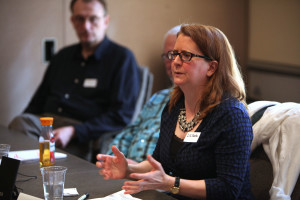 By Allison Opitz
By Allison Opitz
Science writing relies heavily on methods of both fiction and journalism—a delicate combination of literary techniques combined with the factual nature of journalism. A writer should engage the reader by creating characters, conflict, setting, dialogue, and telling details, but with one caveat: It all has to be true. This caution came from author Richard Panek, one of three panelists making up the “Secrets from Skillful Storytellers” session at DCSWA’s 2015 Professional Development Day in Washington, D.C.
The session’s central theme was how to tell a great scientific story, focusing on short, precise narrative. Panek offered a literary perspective; the other two panel members approached the topic from the journalistic side.
Christopher Joyce, a science desk correspondent at NPR, offered tips on how to tell stories orally. “Audio is a visual medium,” he said, where the writer’s task is to create a “movie in somebody’s head.” As a result, the writing must be “lean,” excluding what does not serve to drive the story.
Often, though, writers have difficulty writing shorter, linear pieces, as was the case early in the career of Liz Szabo, a medical news reporter for USA Today. “I would put everything I really think absolutely had to be in there, and it turns out that I needed to cut X number of words,” she said. As a former Victorian literature major, she had been trained to write long, but “being forced [to write short pieces] makes you prioritize” what needs to be there.
All of the panelists stressed the importance of creating a scene, no matter the length of the story. Much of the information for the scene comes from talking with the sources to “make them unpack their story,” as Szabo described, and asking open-ended questions, such as “Why?” or “What do you make of that?” or “And then what happened?” (as suggested by Joyce).
When asked about difficult sources on tough topics, especially in investigations, Szabo said, “Let people talk, because they’ll hang themselves so often.”
“If you want to be everyone’s best friend, choose another profession,” Joyce added.
For good conclusions, writers should “pick closing lines that summarize, but hint at where the story might go,” said Panek. Szabo said that a story should end with “a quote that looks out to the future,” and Joyce said that a story should answer the “so what?” question. Panek added that a conclusion needs to “call back” the original thesis. That way, the story is self-contained and memorable to the reader or listener.
In short, scientific stories use elements of fiction—characters, conflict and resolution, exposition—to tell the truth.
